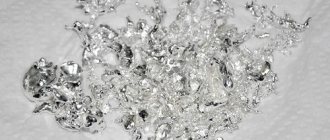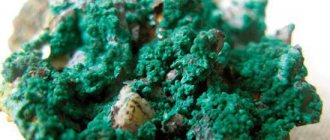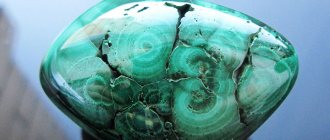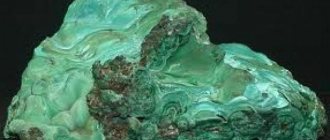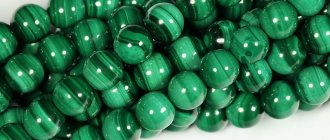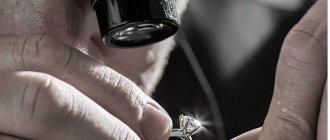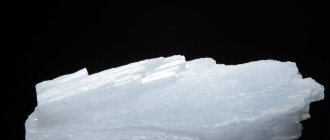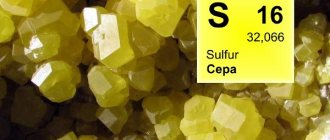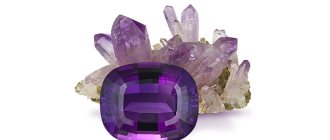Malachite is very widely used in decorative and applied arts. It is a basic copper carbonate, and is interesting not for its color, shine, or shades, but for its complex pattern, which is formed over many years due to natural conditions. For a long time it was not possible to obtain an artificial stone, but now on the market you can find many copies of the mineral synthesized in the laboratory. How to make malachite and is it possible at home?
The answer to this question is only half yes. In nature, malachite is formed in places of copper ore deposits, provided that they occur in carbonate rocks. When copper ore is washed out under the influence of groundwater and oxygen and carbon dioxide dissolved in it, copper goes into solution. This solution contains copper ions, which slowly seep through the limestone and react with it. As a result, basic copper carbonate is formed.
Imitation malachite
There is a chemical reaction that allows you to get malachite at home. In order to do this, you need:
- anhydrous sodium carbonate or calcined baking soda;
- copper sulfate (copper sulfate, copper sulfate);
- funnel;
- Petri dish;
- filter paper;
- cones and vessels.
Anhydrous sodium carbonate and copper sulfate are mixed in equal quantities. Next, the precipitate is filtered using a funnel and filter paper. After this, the paper with the sediment is removed and dried in a Petri dish. This will be malachite powder. Anhydrous sodium carbonate can also be made by baking regular baking soda in a frying pan.
As you can see, this method does not allow one to obtain a stone, but only a powder of the substance.
Industrial production
There are several ways to obtain artificial malachite. The first and most obvious is the use of natural malachite in powder form and sintering it under high pressure. The main process that occurs is that the substance becomes denser and recrystallizes. The same method is used in America to produce turquoise. It is also used to obtain other semi-precious stones of this type.
In our country, such malachite is produced by fusing crushed minerals at a pressure of up to 10 thousand atmospheres; at the same time, the sample must be heated to 100 degrees. The result is a continuous mass in the form of plates.
Another possible method is hydrothermal. It is based on the fact that water acts as a solvent. But since under normal conditions it is capable of dissolving not many substances, certain ones are created - high pressure and temperature. This method produces malachite stone, very similar to natural one. But the main task is to obtain the texture of the stone. At one time, the technology was developed at three Soviet enterprises and is now widely used both here and abroad, for example, in Canada.
A specific technology for producing stone artificially, which would also make it possible to obtain a malachite pattern, is mentioned in many popular science and news magazines. However, no specific recipe is named in the detailed descriptions. It turns out that to this day the technology remains a secret.
Thus, there is no known method for producing malachite at home so that it fully matches the original.
In order to imitate malachite, other methods are widely used.
Who is it suitable for?
Esotericists recommend wearing malachite:
- artists;
- poets;
- writers;
- artists;
- scientists;
- doctors.
Zodiac signs
Libra - nature created this stone for you. Taurus and Capricorn will receive full magical and healing help from the gem.
Malachite is not very suitable for Cancers, Scorpios, and Virgos. Treatment with the mineral is acceptable for them.
The rest of the zodiac signs can wear jewelry with a green gem as decoration and for magical purposes.
Is Malachite right for you?
Not really
Element
Earth
Planets
Moon
Saturn
Energy
Yin
Types and colors of stone
With green color, which is the main color for malachite, various shades are distinguished from the lightest to almost black. The varieties are given only a description; they are not given names.
Thus, African stones have rings of regular shape, larger in size than those of the Ural specimens. Contrast and brightness also make them stand out.
Natural malachite is a stone that is divided according to its color properties into the following subspecies:
- Plush or velvet with a fabric-like texture corresponding to the name. The fine-grained structure creates difficulties during processing, but the crafts are particularly beautiful.
- A finely patterned appearance with a cut pattern similar to birch leaves. Rarely discovered, it was considered to be of great value in the Urals.
- Pseudomalachite with a turquoise color is harder than real malachite, which is not considered to be.
It happens that the stone contains impurities of chrysocolla or other minerals. The color and pattern of the sample also changes in this case.
Basic information about the stone
Malachite is a semi-precious mineral of amazing beauty. Its name comes from the Greek word “malakos”, which means “soft”. The color of the stone ranges from delicate light green to deep dark turquoise. The gem is covered with concentric patterns, their outlines can be either lighter or darker than the main color of the mineral - they go deep and slide along the surface, twist in spirals and bloom in clusters.
Crystals are especially beautiful when polished; they are often used to make various decorative items, and less often - jewelry. The mineral is so remarkable in appearance that it has even been immortalized in literature - in the middle of the last century, the writer Pavel Bazhov published a collection of “tales of the old Urals” and called it “Malachite Box”.
At all times, malachite was deified, endowed with magical properties, considered a talisman against the evil eye, protection from enemies and evil spirits, but in this article we will look at the stone with the strict gaze of science.
Chemistry of malachite rock formation
Malachite is formed in sources of copper ores, in a situation where ore deposits are located in carbonate rocks such as limestone and dolomite. It is often accompanied by sulfide minerals such as chalcocite and bornite. Malachite deposits are primary, that is, they do not migrate over time.
The mineral is usually located on the surface of the soil, it rarely lies deep, and therefore the sources dry up quite quickly. The situation is paradoxical, the stone is not rare, but in order to satisfy demand, you need to constantly look for new mines, which is not very profitable, given the relatively low price of the gem. This paradox is the reason for the huge number of counterfeits of a stone common in nature.
Gems are formed as a product of a hypergene process, that is, due to the weathering of copper-containing ores. Let's delve into the chemistry of the main stages of this process:
- Copper rock is exposed to groundwater; carbon dioxide and oxygen are dissolved in this underground life-giving moisture, which also go into solution and determine the final chemical formula of the mineral;
- The resulting solution seeps through the limestone rock;
- At the moment of seepage, the final reaction occurs and malachite is gradually formed.
The process of rock formation is best studied in quarries. By-products resembling stalactites and stalagmites can be observed, they are formed when droplets of copper solution evaporate in the voids.
Physical properties of malachite
The rock crystallizes in the so-called monoclinic system. Large crystals are not often found; they have short and long prismatic outlines with different faces. There are stones in the form of needle-shaped and fibrous structures.
- Color. The stone amazes with its variety of shades - in nature you can find a mineral of the entire green palette. By the way, copper ions cause the green color.
- Transparency. Usually the stone is opaque, but if the crystal is small, it will be transparent to light. This is an important point to consider when checking for authenticity. Many people believe that transparent malachite is an absolute fake, however, when it comes to a small crystal, the situation is not so clear.
- Shine. Most of the “varieties” of the mineral have a soft and subtle shine. But there are also special types of rock that have a brighter shine. However, the stone never gives a “glassy” glow; such a reflection can only be seen on a fracture of untreated rock. All of these subtleties are also important for determining the authenticity of the mineral.
The gem has a hardness of 3.5-4 on the Mohs scale and a density of 3.7-4.1 g/cm3.
Malachite does not tolerate heat well; even with a relatively small increase in temperature it begins to deteriorate. The critical threshold is 2000C; when this temperature is reached, the stone turns black before our eyes and crumbles into pure copper oxide powder; in this chemical reaction, carbon dioxide - CO2 - evaporates and water - H2O - condenses.
What does a real mineral look like?
Natural malachite is not translucent and has a low density, which makes it easier to process. The treated surface of the mineral reveals a bizarre pattern of blurry curved rings, painted in different shades of green. The color shimmers and smoothly transitions from almost colorless to dark emerald green. All this is in strict sequence, each ring has its own shade, as if a skilled artist had carefully drawn the pattern. Single-color fragments are rare.
Before processing, the sample may have a glassy sheen. But after polishing it acquires a delicate silky sheen. The stone is heat sensitive and may partially disintegrate in hot water.
During the era of the Soviet Union, Ural malachite was famous, which was mined near Sverdlovsk. Today, the main supplies of the mineral come from Zaire. Stones are also mined in the USA, Namibia, Chile, Australia, Zimbabwe, Kazakhstan and the Urals.
Color shades will tell you how to distinguish malachite from its analogue. The production of imitations is on stream; they don’t think about the variety of colors.
Therefore, stones similar to malachite are painted in 2-3 green shades and no more. Take a close look at the sample: if only three green color options alternate in it, then you have a fake mineral in your hands. Natural stone has a pattern of lines of similar but unequal shades of emerald color. The number of green gamut options reaches ten or more.
How to buy, wear, care
The best time to buy jewelry is the green period. These are spring, when nature blooms, and the summer months until August. It is not recommended to acquire talismans in winter and autumn, since energy can be directed towards fading.
Rings with natural malachite are usually worn on the middle finger or little finger of the left hand.
There are no special rules for beads and bracelets. It is only necessary to aesthetically observe the rules of color combinations and compatibility with other stones. And also protect the decoration from damage. It is very easy to scratch; shocks and temperature changes are undesirable. Should be protected from household chemicals and acid exposure. Cleaning is done with a soft piece of cloth using a weak soap solution.
Synthetic fakes
Scientific laboratories have developed a method for producing synthetic malachite. The technology for manufacturing artificial stone makes it possible to obtain a mineral through synthesis that is extremely difficult to distinguish from natural one. The production of artificial stone makes it possible to replace its natural samples in stone cutting. For example, for cladding various architectural fragments inside a building, given the high price of natural material.
When buying jewelry on the market, you should not expect magical or healing properties from it. Such products are attractive and beautiful, but they have the properties of glass or plastic, and not valuable natural stone. Therefore, you should look for the original in specialized jewelry stores, where they will show you documents confirming the natural origin of the product.
When wondering how to make the right choice in favor of the original, it makes sense to go to the geology museum. There you can carefully examine the pattern written by nature, feel its energy and magnetism.
Pressed mineral
Often, when a buyer doubts the authenticity of a material, the seller argues the quality by saying that it is a pressed sample. Pressed malachite is usually of natural origin, but of low grade. It consists of fragments and stone fragments of different sizes, pressed together and joined with epoxy resin. In these samples, sharp edges of fragments and partitions between inclusions are visible. Zones of epoxy resin with pebbles floating in it are clearly visible in the mineral.
Some pressed malachite products are very beautiful, but the quality is still lower than usual, and the price should not be increased accordingly.
